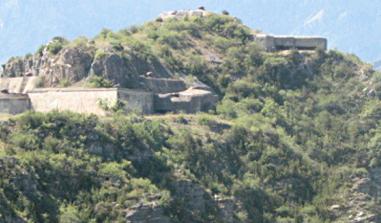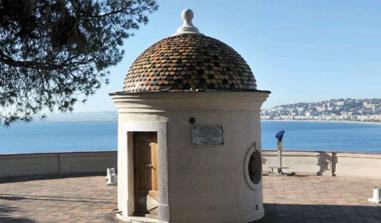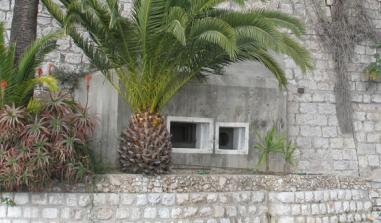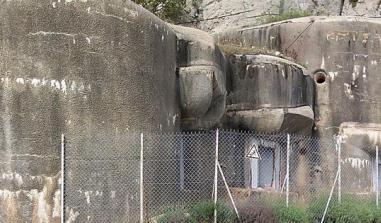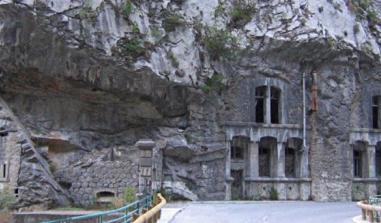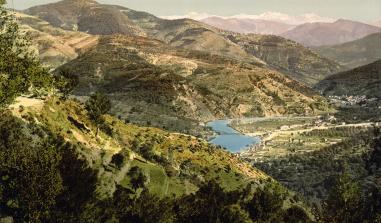Fort du Pic Charvet or Picciarvet
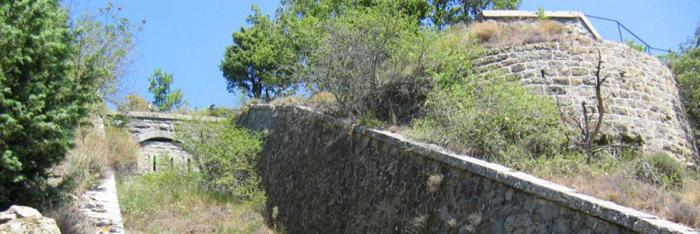
Fossé de gorge protégeant le flanc ouest. Au fond, la caponnière. Source : http://fortification.pagesperso-orange.fr
Characteristic of the military art of Séré de Rivières, the Fort du Pic Charvet protects the city of Nice. It contributes to the control of the strategic route along the Var Valley.
The building, built between 1883 and 1890, sits on a rocky outcropping overlooking the confluence of the Tinée and the Var, north of Nice.
The treaty of 1860 brought Nice and Savoy under French control and forced the French army to redefine its plans for defending the southeast border with Italy. The young Italian State, unified by the Piedmont royal family, sought to make its mark by controlling its territory with fortifications on the Col de Tende and through a trade and customs war. A policy of systematic opposition to France led Italy to join the Triple Alliance in 1882.
Séré de Rivières, in charge of establishing a line of defence along the northeast border, expanded his system to the Italian border, as he was well aware of the threat: “Since, through a series of annexations made possible by French policy, the King of Piedmont has become the King of all of Italy and rather than having neighbours who are incapable of causing us any umbrage, we are in contact with a first-class power, the Alpine border has taken on great importance.”
The first step consisted in controlling all the approaches to Nice, transforming the city into a resistance position. Nice played the role of the core surrounded by a line of defence made up of forts set up on natural outcroppings, within shooting distance of each other. It quickly became necessary to push the line of defence closer to the border.
A second fortified line was set up, rounding out the system of strategic roads started in 1877. It should be pointed out that his predecessor, Engineering General Frossard, had already planned in 1862 to defend Nice and to control the gorges of the Var and the Tinée with a system of two “chuise” and four forts.
The “explosive shell crisis” made the “first generation” of the Séré de Rivières forts partially useless.
The Fort du Pic Charvet, or Picciarvet, is a typical construction in the system. It is part of a vast defensive system comprising 158 forts and 254 artillery batteries in charge of safeguarding the border.
The Fort du Pic Charvet is a protective fort. The building is surrounded by a ditch that protects the west side, which is more vulnerable. It is defended by caponiers. No large façades are visible. Only a few walls and a cannon ramp can be seen. The heavy machinery includes four 120-mm cannons, heavy weapons to ensure the fort’s role.
With the law of 22 December 1889, General Baron Berge created the “Alpine batteries” each of which was to be paired off with the Chasseurs Alpins battalion at the nearest fort. These batteries are equipped with the 80-mm De Bange cannon, called the “mountain gun”, a rifled cannon that could be broken down into three loads of approximately one hundred kilos which can be transported by mules using a packsaddle: the carriage, the pointer extension with the wheels. This cannon has a range of 4,100 metres. The 65-mm mountain gun replaced it in the end. This is a fast-firing gun with an articulated carriage. It weighs 400 kilos. It is made up of four loads for mule transport: the gun, the brake, the pointer, and the wheels. Its maximum range is 5,500 metres and its firing speed can reach 10 to 15 shots a minute. The fort was occupied until World War II by the 18th battalion of Chasseurs Alpins.
Syndicat d'initiative de Villars sur Var
Tel.: +33 (0)4.93.05.32.32
Tournefort Town Hall
Tel.: +33 (0)4.93.02.90.56
Access: on foot, take the path from the village of Tournefort
Association Montagne et Traditions
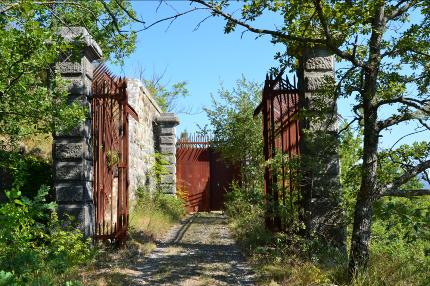
L?entrée du fort du Pic Charvet. Cliché VAUBOURG Julie
Practical information
6710
Tournefort
04 93 02 90 56
Le fort ne se visite pas



